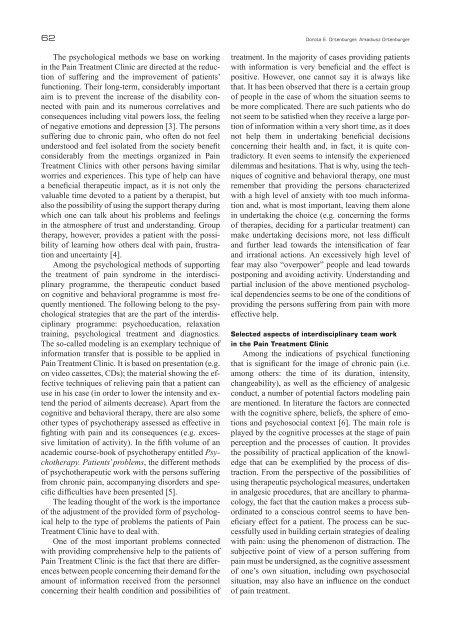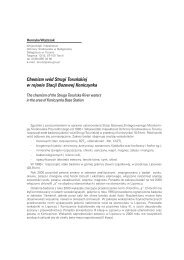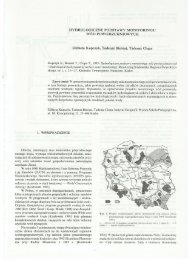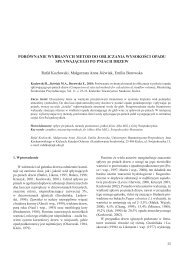25/2012 - Uniwersytet Jana Kochanowskiego w Kielcach
25/2012 - Uniwersytet Jana Kochanowskiego w Kielcach
25/2012 - Uniwersytet Jana Kochanowskiego w Kielcach
Create successful ePaper yourself
Turn your PDF publications into a flip-book with our unique Google optimized e-Paper software.
62 Dorota E. Ortenburger, Arkadiusz Ortenburger<br />
The psychological methods we base on working<br />
in the Pain Treatment Clinic are directed at the reduction<br />
of suffering and the improvement of patients’<br />
functioning. Their long-term, considerably important<br />
aim is to prevent the increase of the disability connected<br />
with pain and its numerous correlatives and<br />
consequences including vital powers loss, the feeling<br />
of negative emotions and depression [3]. The persons<br />
suffering due to chronic pain, who often do not feel<br />
understood and feel isolated from the society benefit<br />
considerably from the meetings organized in Pain<br />
Treatment Clinics with other persons having similar<br />
worries and experiences. This type of help can have<br />
a beneficial therapeutic impact, as it is not only the<br />
valuable time devoted to a patient by a therapist, but<br />
also the possibility of using the support therapy during<br />
which one can talk about his problems and feelings<br />
in the atmosphere of trust and understanding. Group<br />
therapy, however, provides a patient with the possibility<br />
of learning how others deal with pain, frustration<br />
and uncertainty [4].<br />
Among the psychological methods of supporting<br />
the treatment of pain syndrome in the interdisciplinary<br />
programme, the therapeutic conduct based<br />
on cognitive and behavioral programme is most frequently<br />
mentioned. The following belong to the psychological<br />
strategies that are the part of the interdisciplinary<br />
programme: psychoeducation, relaxation<br />
training, psychological treatment and diagnostics.<br />
The so-called modeling is an exemplary technique of<br />
information transfer that is possible to be applied in<br />
Pain Treatment Clinic. It is based on presentation (e.g.<br />
on video cassettes, CDs); the material showing the effective<br />
techniques of relieving pain that a patient can<br />
use in his case (in order to lower the intensity and extend<br />
the period of ailments decrease). Apart from the<br />
cognitive and behavioral therapy, there are also some<br />
other types of psychotherapy assessed as effective in<br />
fighting with pain and its consequences (e.g. excessive<br />
limitation of activity). In the fifth volume of an<br />
academic course-book of psychotherapy entitled Psychotherapy.<br />
Patients’ problems, the different methods<br />
of psychotherapeutic work with the persons suffering<br />
from chronic pain, accompanying disorders and specific<br />
difficulties have been presented [5].<br />
The leading thought of the work is the importance<br />
of the adjustment of the provided form of psychological<br />
help to the type of problems the patients of Pain<br />
Treatment Clinic have to deal with.<br />
One of the most important problems connected<br />
with providing comprehensive help to the patients of<br />
Pain Treatment Clinic is the fact that there are differences<br />
between people concerning their demand for the<br />
amount of information received from the personnel<br />
concerning their health condition and possibilities of<br />
treatment. In the majority of cases providing patients<br />
with information is very beneficial and the effect is<br />
positive. However, one cannot say it is always like<br />
that. It has been observed that there is a certain group<br />
of people in the case of whom the situation seems to<br />
be more complicated. There are such patients who do<br />
not seem to be satisfied when they receive a large portion<br />
of information within a very short time, as it does<br />
not help them in undertaking beneficial decisions<br />
concerning their health and, in fact, it is quite contradictory.<br />
It even seems to intensify the experienced<br />
dilemmas and hesitations. That is why, using the techniques<br />
of cognitive and behavioral therapy, one must<br />
remember that providing the persons characterized<br />
with a high level of anxiety with too much information<br />
and, what is most important, leaving them alone<br />
in undertaking the choice (e.g. concerning the forms<br />
of therapies, deciding for a particular treatment) can<br />
make undertaking decisions more, not less difficult<br />
and further lead towards the intensification of fear<br />
and irrational actions. An excessively high level of<br />
fear may also “overpower” people and lead towards<br />
postponing and avoiding activity. Understanding and<br />
partial inclusion of the above mentioned psychological<br />
dependencies seems to be one of the conditions of<br />
providing the persons suffering from pain with more<br />
effective help.<br />
Selected aspects of interdisciplinary team work<br />
in the Pain Treatment Clinic<br />
Among the indications of psychical functioning<br />
that is significant for the image of chronic pain (i.e.<br />
among others: the time of its duration, intensity,<br />
changeability), as well as the efficiency of analgesic<br />
conduct, a number of potential factors modeling pain<br />
are mentioned. In literature the factors are connected<br />
with the cognitive sphere, beliefs, the sphere of emotions<br />
and psychosocial context [6]. The main role is<br />
played by the cognitive processes at the stage of pain<br />
perception and the processes of caution. It provides<br />
the possibility of practical application of the knowledge<br />
that can be exemplified by the process of distraction.<br />
From the perspective of the possibilities of<br />
using therapeutic psychological measures, undertaken<br />
in analgesic procedures, that are ancillary to pharmacology,<br />
the fact that the caution makes a process subordinated<br />
to a conscious control seems to have beneficiary<br />
effect for a patient. The process can be successfully<br />
used in building certain strategies of dealing<br />
with pain: using the phenomenon of distraction. The<br />
subjective point of view of a person suffering from<br />
pain must be undersigned, as the cognitive assessment<br />
of one’s own situation, including own psychosocial<br />
situation, may also have an influence on the conduct<br />
of pain treatment.












